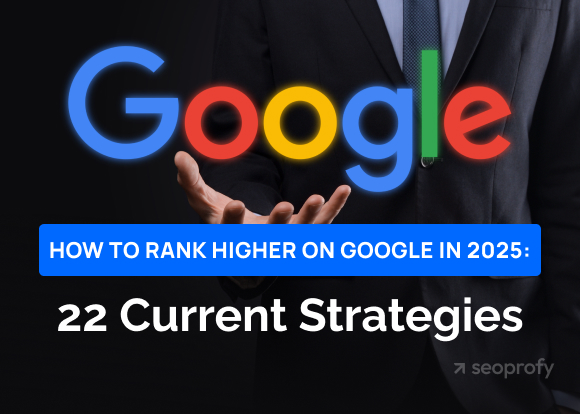We have examined leading online banks that rank highly for priority search queries. Organic search is their second largest traffic source. For example, American Express National Bank’s monthly organic search traffic is over 20 million. This highlights the crucial role of SEO for banks aiming to dominate search results.
Banking is a sensitive field where trust is important. People are understandably cautious with their money and personal information. This extends to the internet, where concerns about safety make potential customers hesitant to engage with unfamiliar financial institutions. Search engine optimization for banks can help build online visibility and credibility to ensure business growth.
- Bank SEO aims to improve Google rankings, attract clicks, and convert visitors into new customers.
- Mobile optimization is critical, as 60.74% of all global website traffic came from mobile devices in June 2024.
- 83% of customers still prefer face-to-face banking services. This highlights the importance of local SEO for banks.
- Continuous SEO performance tracking and adjustment are necessary as Google algorithms and user behaviors change.
What Is SEO for Banks?
Banking SEO is an approach to improving financial institutions’ search engine rankings. However, just showing up in search results isn’t the final goal of SEO for banking. It’s only the first step.

Another aim is to get more organic traffic. Once users are on the site, the goal is to keep them there and turn them from visitors into clients — ideally, loyal clients who use the bank’s services for a long time.
The Importance of Search Engine Optimization for Banks
Banks can’t afford to be invisible online when people often turn to Google for answers. Let’s see exactly why your financial organization should care about SEO:
- Bringing in the right visitors. SEO doesn’t just bring in more people to a website; it brings in the right people. By using specific keywords, banks can attract visitors who are more likely to become customers.
- Improving user experience. An effective SEO strategy often leads to better UX overall. This means faster loading times, easier navigation, mobile-friendly designs, and more. The latter is particularly critical given that in June 2024, 60.74% of all website traffic worldwide came from mobile devices.
- Showing up in local search results. For regional or local institutions, being found by people nearby is crucial. SEO can help a local bank appear on the first page when someone searches for “banks near me” or “best mortgage rates in [town name].” In fact, the close rate of leads from search engines is 14.6%. Conversely, only 1.7% of outbound leads end up becoming customers.
- Keeping up with new trends. Banking is changing fast, with new financial solutions emerging all the time. SEO enables banks to stay relevant by making sure they show up in searches for these new services. Whether it’s online banking or automated investing, SEO keeps banks in the game.
- Building for the long term. Unlike ads that stop working when you stop paying, SEO keeps working over time. Once a bank builds up its SEO strength, it continues to benefit.
So, search engine optimization for banks is a way to connect with people looking for financial services, build trust, and grow in a world where people often look online first.
SEO Challenges for Banks
Yet, while SEO offers numerous benefits for banks, it also comes with its own set of obstacles to overcome. First of all, the sheer size and complexity of bank websites — with numerous products, services, and informational pages — makes implementing site-wide technical recommendations one of the common SEO issues in banking. It often requires careful planning and execution to ensure that improvements in one area don’t negatively impact others.
Furthermore, due to the highly competitive nature of the financial industry and the fact that numerous banks are targeting the same keywords and audience, standing out in search results can be difficult. This intense competition often leads to higher costs for SEO efforts and requires more creative strategies to gain an edge.
At SeoProfy, we believe in transparency when working with our clients. Our strategies are designed to address these issues of SEO for banks head on.
Don’t let SEO challenges hold your bank back. Our specialized audit can reveal crucial issues in banking SEO, including:
- Technical barriers
- Mobile optimization gaps
- Lack of localized content for different regional markets.

The Best Banking SEO Strategy in 2024
Google uses more than 200 ranking factors to decide whether your website appears first in search results. Our SeoProfy team has boiled them down to the essentials. Below, we share the main aspects of fintech SEO that you should include in your digital marketing campaign:
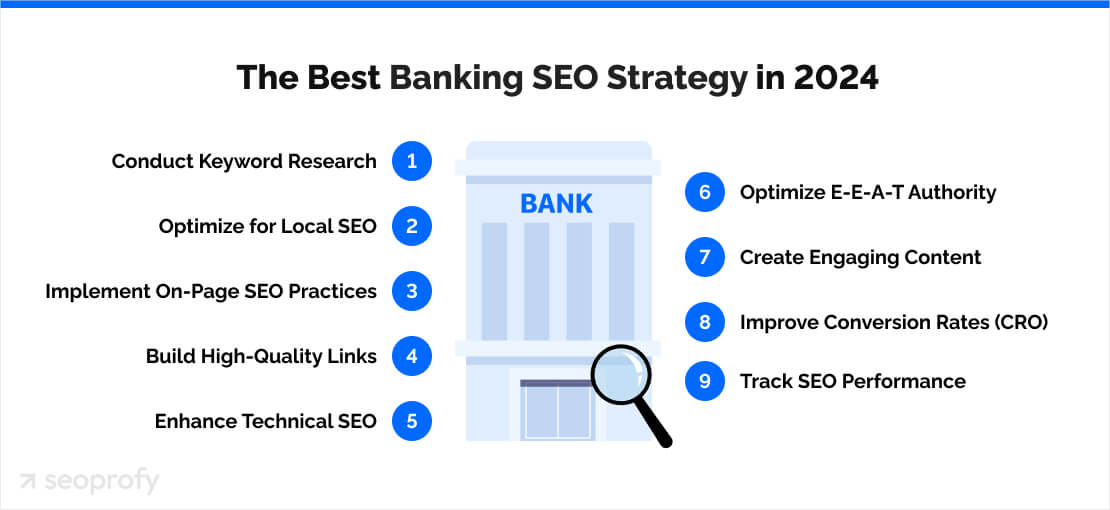
- Keyword research
- Local SEO
- On-page SEO practices
- Link building
- Technical SEO
- EEAT authority optimization
- Content creation
- Conversion rate optimization
- SEO performance tracking.
Keyword Research
Keywords research is a fundamental step in all SEO strategies for banks. It’s the process of identifying the specific words and phrases potential customers use when searching for banking services online.
So, why is keyword research so important for banks? First, it lets you uncover more specific phrases your target audience may use. Take a look at the screenshot showing the search statistics for the keyword “bank”.
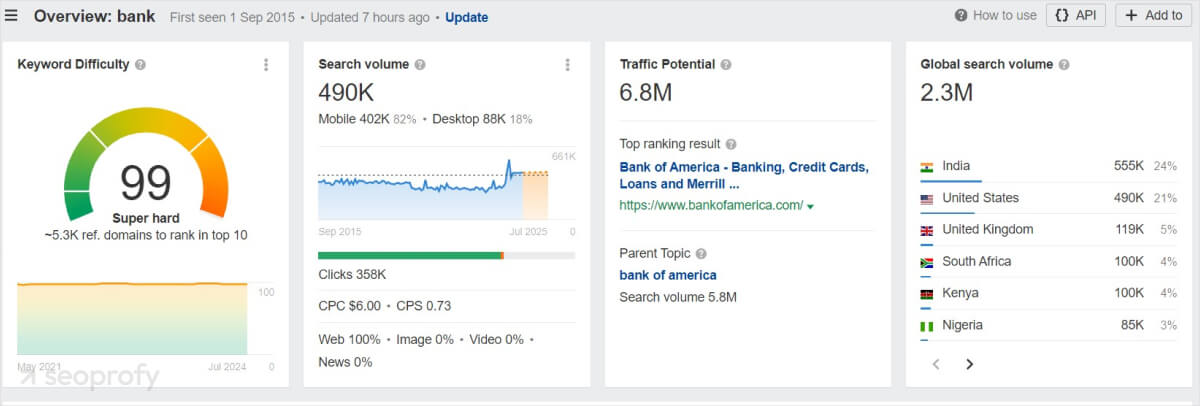
It gets 490,000 monthly searches in the US, but with a difficulty score of 99/100, it’s nearly impossible to rank for, so, it’s quite a broad term. You should find and use more phrases with narrower meanings that are relevant to your particular organization.
In addition, keyword optimization helps you speak the language of your potential customers. While bankers might use terms like “high-yield savings account” or “fixed-rate mortgage“, everyday people might search for “best savings account” or “home loans“.
Local SEO
Despite the rise of neobanking, there’s still a significant amount of customers (according to UserTesting — 83%) who prefer face-to-face service. That’s why local SEO is crucial for banks, especially those serving specific geographic areas. However, local SEO for major banks will work similarly.
Local optimization focuses on keywords like “ATMs in downtown Chicago” or “bank near me.” As you can see on the screenshot, the phrase “bank near me” has a high search volume — 71,000 monthly searches, with 90% coming from mobile devices (as people often look for local businesses while on the go).
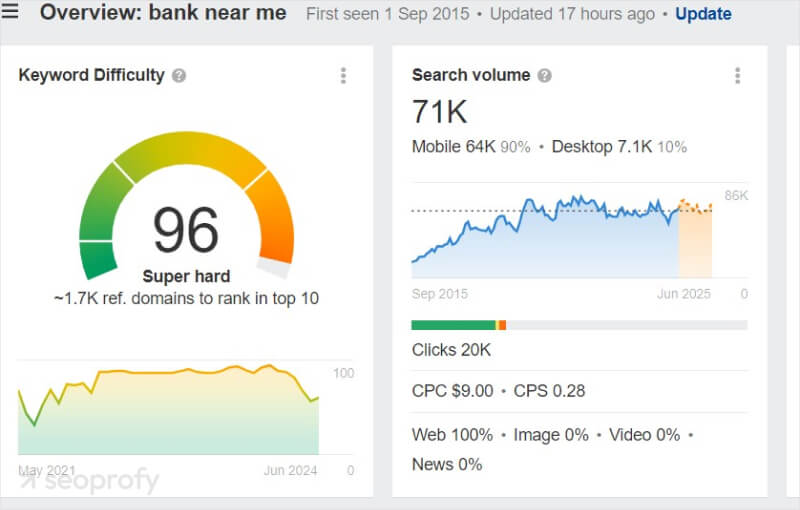
Another essential aspect of SEO for regional banks is optimizing your Google Business Profile. Each branch’s profile should include accurate business hours, a phone number, services offered, photos, and more. The screenshot shows a Google Maps search result for “bank Los Angeles“. Each marker on the map and each listing on the left represents an opportunity for a bank to attract local customers.
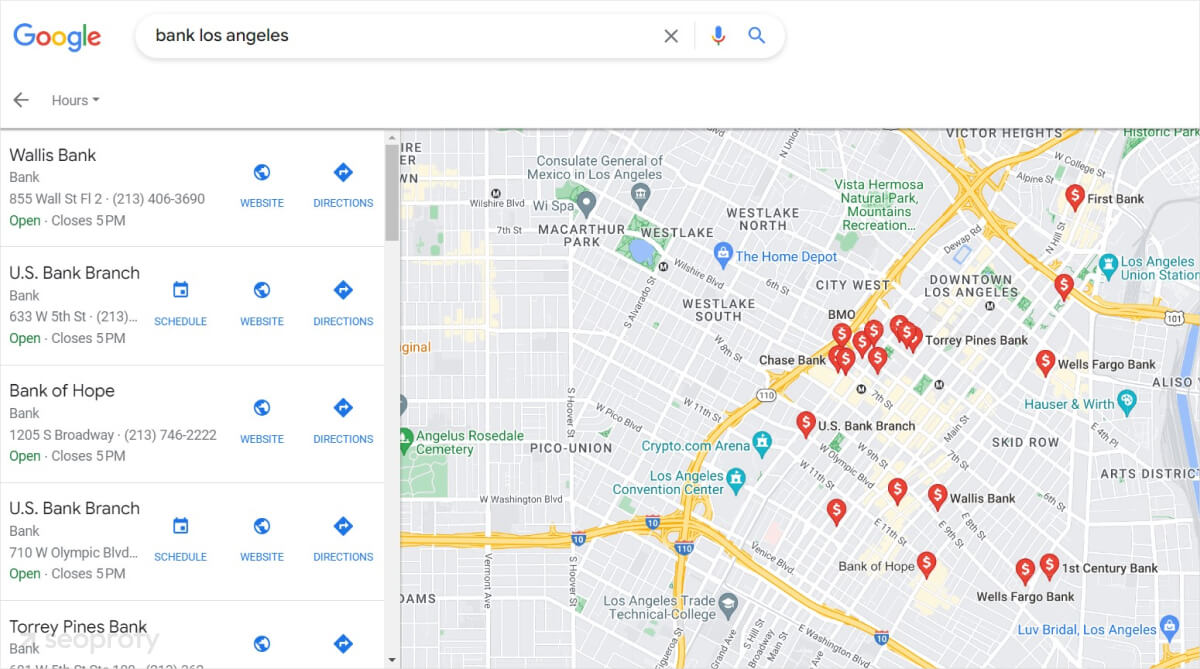
On-Page SEO Practices
On-page SEO refers to the techniques used to optimize individual web pages to rank higher in search engines and attract more relevant traffic. Let’s explore three main elements of on-page SEO that can help you increase your bank’s online presence:
- Meta titles are the clickable headlines shown in search engine results pages (SERPs). They should be concise (typically under 60 characters) and include the bank’s name, the primary service offered on the page, and more.
- Meta descriptions appear beneath the title in search results, providing a summary of the page’s content and highlighting unique selling points.
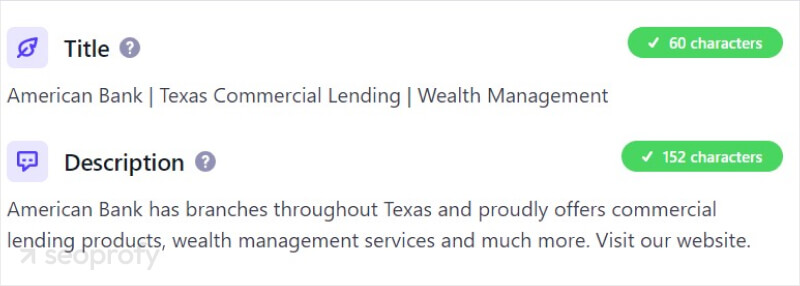
- Page structure refers to how content is organized and presented on a webpage. A well-structured web page helps both users and search engines navigate and understand the content. Key aspects of good page structure are hierarchical headings (H1, H2, H3) and the main headline (H1) containing the primary keyword.
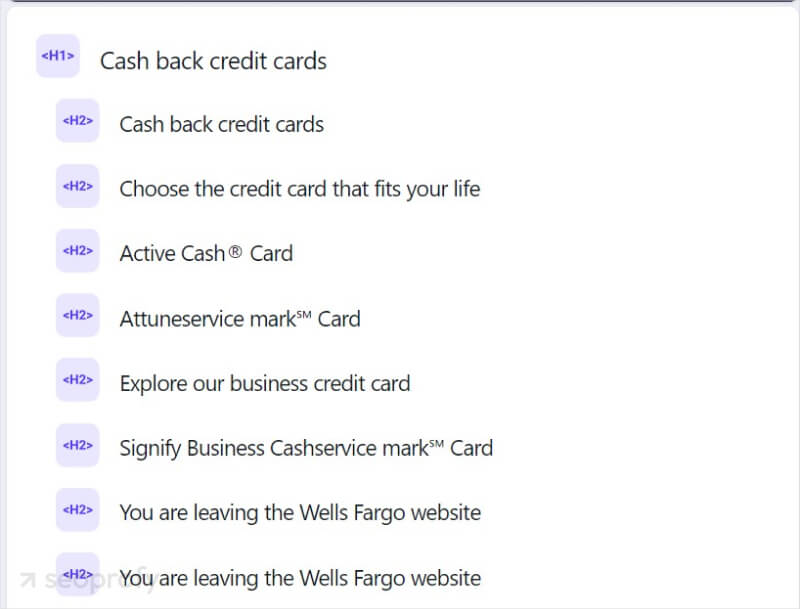
- URL structure is how the web address of a page is formatted. Best practices for URL structure include keeping them short yet meaningful, incorporating relevant keywords, and using hyphens to separate words.
Search engine optimization isn’t confined to on-page elements alone. A complete strategy also involves off-page SEO practices.
Link Building
Off-page SEO refers to actions taken outside of a bank’s website to improve its search engine rankings. At its core is link building — acquiring high-quality backlinks from third-party sources.
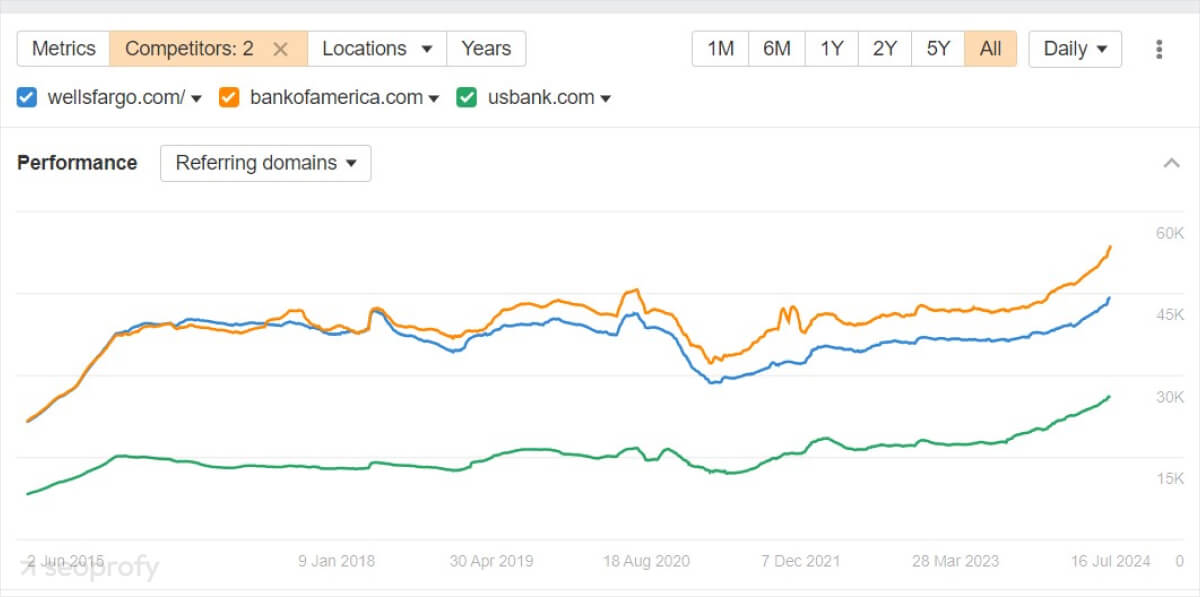
Let’s explore some effective off-page practices your financial institution can use:
- Guest posting opens doors for banks to showcase their expertise on other respected platforms.
- Outreach link building for banks involves directly contacting website owners to request backlinks. You could provide informative content other sites might want to link to.
- Digital PR is the evolution of traditional public relations. Some of the ways your bank can use digital PR are participating in industry interviews or podcasts and participating in financial literacy events to gain media coverage.
- Niche directories, when it comes to banking, are finance-specific ones. You should consider listings in local business hubs or industry association member lists.
Such a well-rounded off-page link-building SEO campaign will not only improve your bank’s search engine rankings but also enable it to build trust with potential customers.
Technical SEO
Technical SEO focuses on improving the technical aspects of a website to increase visibility and enhance the user experience. Here are the main technical search engine optimization practices for banks:
- Page speed isn’t just about impatient users; it’s a critical factor in search rankings. If your website doesn’t load fast, you can try optimizing image sizes or leveraging browser caching.
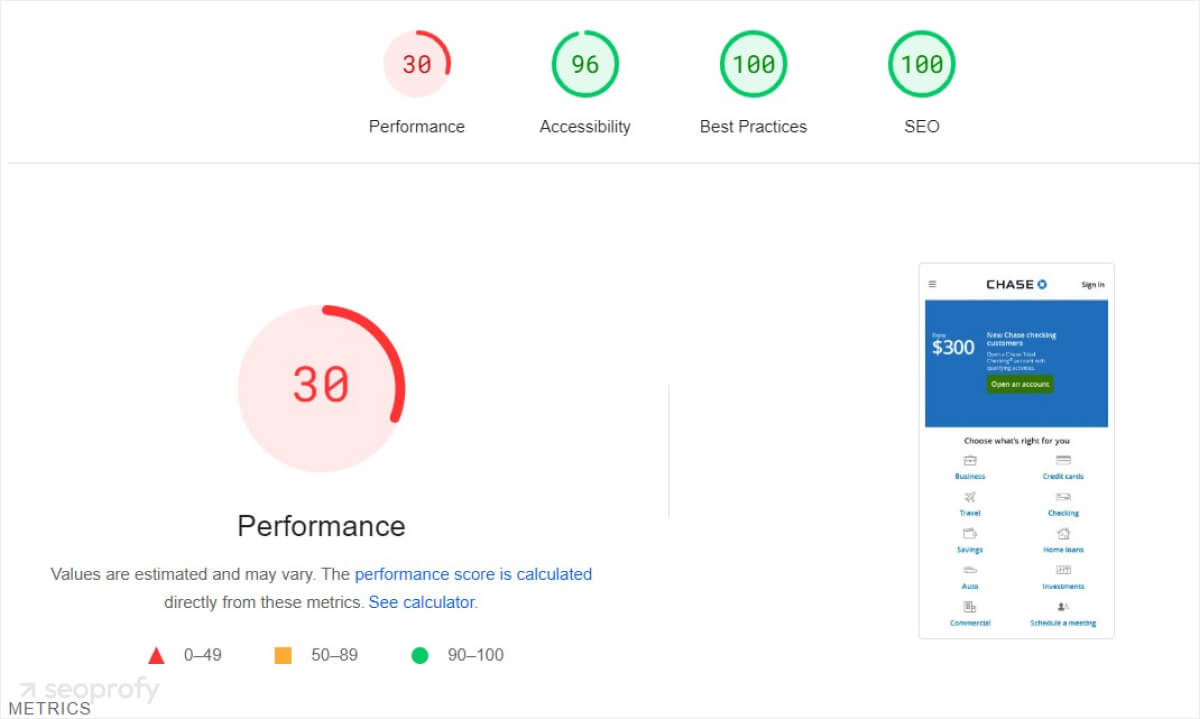
- Schema markup helps Google understand the content and context of your web pages. Specific schemas can be implemented for financial products, customer reviews, and FAQs.
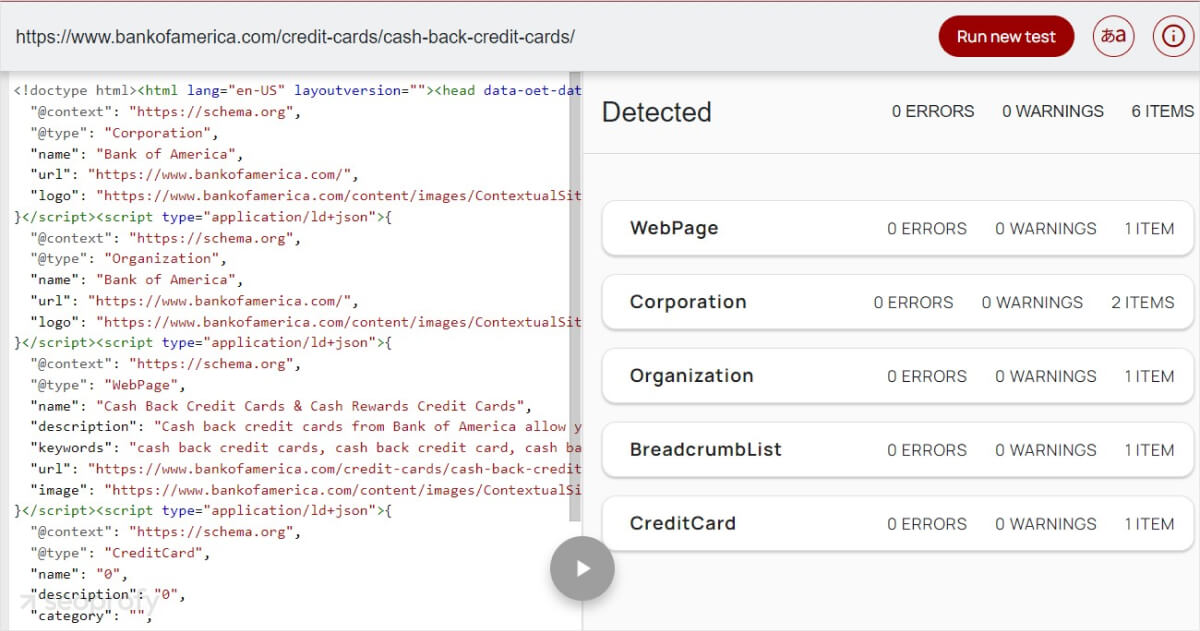
- Sitemap.xml guides search engines through your website, ensuring all important pages are discovered and indexed. Make sure to include all crucial pages, their last update times, and change frequency information.
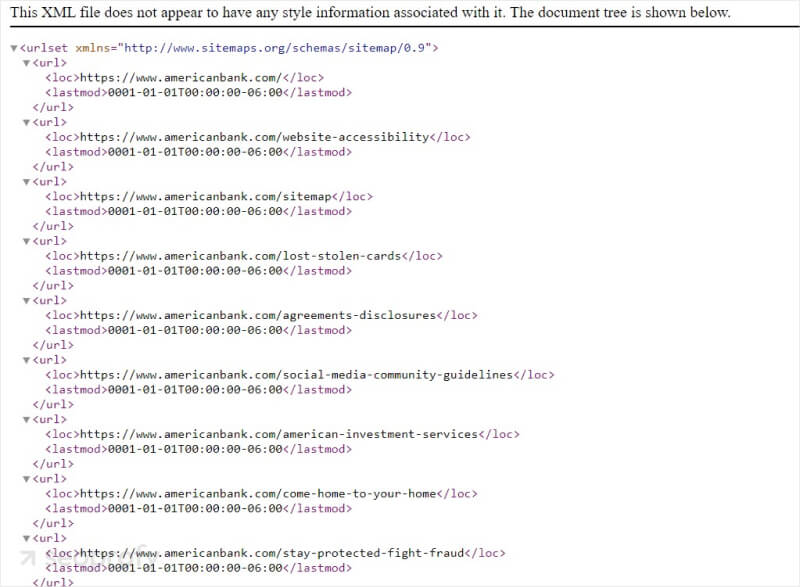
- Robots.txt tells search engine crawlers which areas to explore and which to avoid. Use it to guide them to the most valuable content.
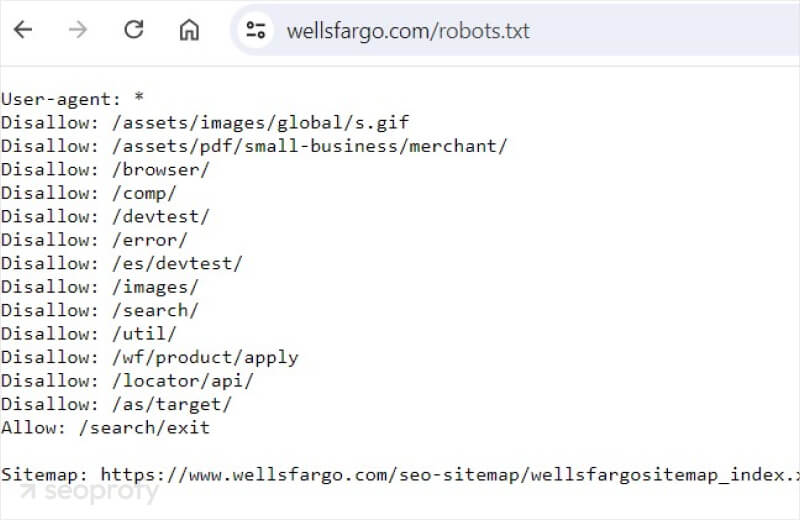
- 404 pages. Even in the meticulously organized world of bank websites, users may end up on non-existent pages. Custom 404 error pages turn these dead-ends into opportunities.
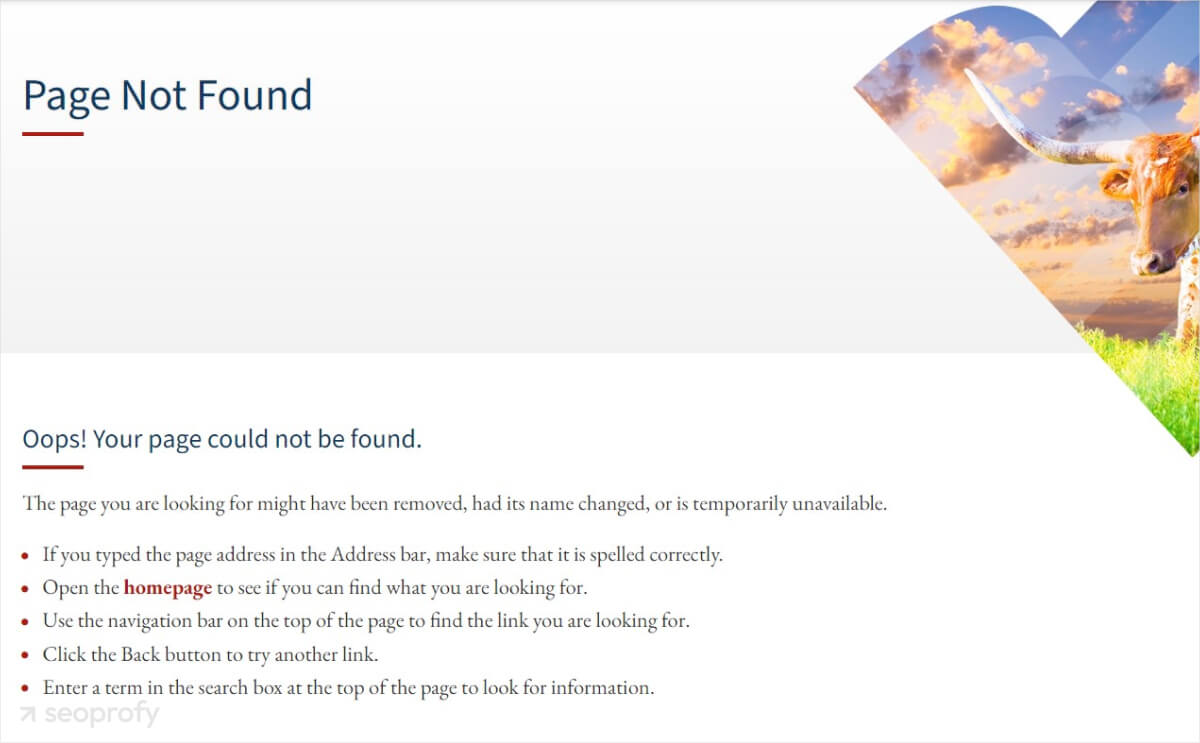
- Website navigation helps visitors find what they need on your bank’s website. It’s necessary to use simple menu headings and ensure there is a logical URL structure.
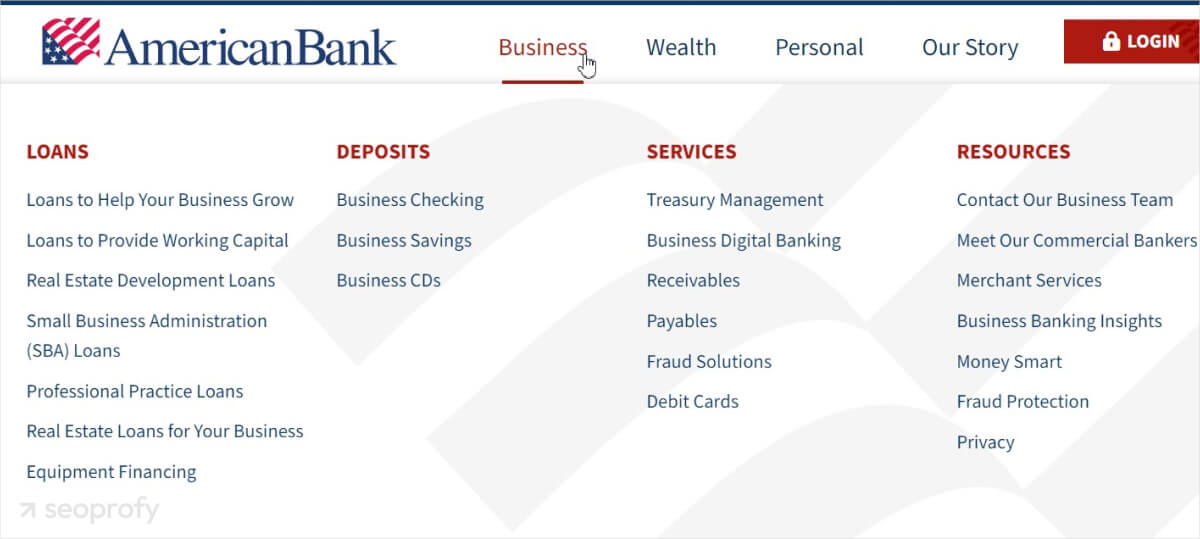
This technical foundation supports all other SEO efforts, from content marketing to local SEO strategies. If these technical details seem overwhelming, consider financial SEO services. A professional SEO partner will identify any issues and advise you on solutions, taking the complexity out of the process for you.
Whether you’re a banking branch seeking local SEO or an established financial institution requiring SEO for enterprise businesses, SeoProfy is at your service!
E-E-A-T Authority Optimization
Even if you achieve high rankings and increase your site visits, there must be something that will make visitors stay, and that’s EEAT — experience, expertise, authoritativeness, and trustworthiness. Experience is your bank’s history. You could share stories of how the bank has helped customers over the years. Expertise showcases the financial acumen of a bank’s team. Here, you could highlight the qualifications of your personnel.
Authoritativeness extends beyond the bank’s website optimization. Just like off-page SEO, it involves activities, like contributions to respected financial publications. Finally, trustworthiness is about being reliable, which is paramount in banking. Your bank’s trustworthiness can be reflected in credentials and security measures.
Content Creation
As E-E-A-T turns businesses into storytellers and educators, content creation is quite helpful here. You can use various formats in your content strategy to showcase your expertise and assist clients with their questions.
For example, in your guides, picture a colorful chart showing how small daily savings can grow into a comfortable retirement fund. Infographics like that can simplify and help people visualize complex financial topics. Also, consider FAQs that address common queries, saving time for both customers and staff. In addition, product comparisons enable new customers to explore all the choices available.
Conversion Rate Optimization
Conversion rate optimization (CRO) is the process of increasing the percentage of website visitors who take desired actions. For banks, this could mean opening accounts, applying for loans, or signing up for credit cards.
CRO matters because it’s often more cost-effective to convert existing customers than to attract new ones. The following CRO practices are simple yet efficient:
- Reduce load times to prevent visitor abandonment.
- Ensure a seamless experience for mobile banking users.
- Include online reviews.
- Communicate the unique benefits of your banking products upfront.
- Offer immediate assistance to hesitant customers via live chats.
- Use clear and engaging calls to action.
- Simplify your account opening and loan application processes.
While some of these practices may seem distant from SEO, they’re actually integral to it. SEO, as we mentioned, doesn’t stop at increased organic traffic; its ultimate goal is to boost your business ROI.
SEO Performance Tracking
SEO is a dynamic, strategic process as search engines update their algorithms and user habits evolve. That’s why you should constantly track your SEO performance to gain valuable insights.
When you see your rankings rise, it’s a chance to understand what’s working well. Equally, drops in rankings or shifts in user search terms signal that you should reconsider your strategy.
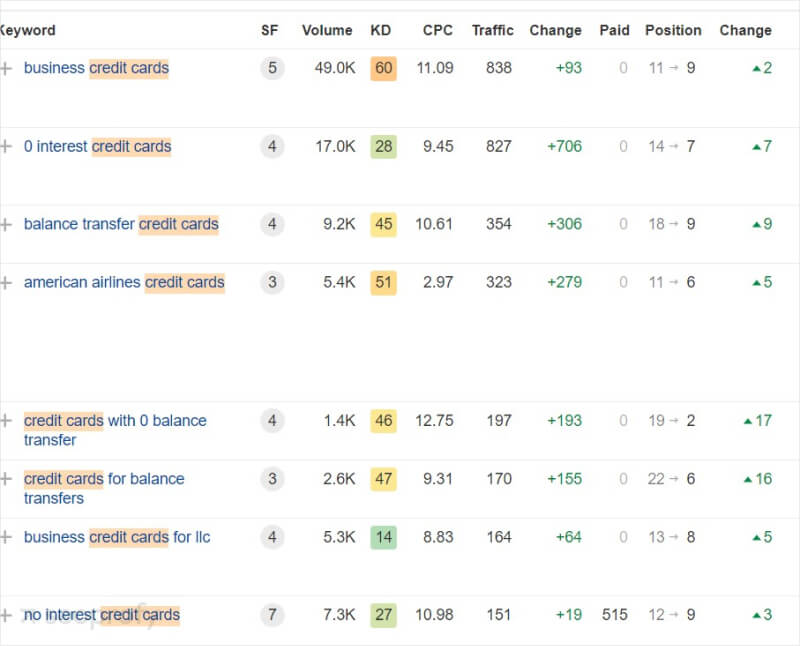
Regularly monitor and adjust your SEO efforts, and you’ll stay in sync with current user needs and search trends.
Conclusion
Today, you have learned more about SEO optimization for banks. Here are some of the things you need to keep in mind:
- Local SEO is vital for banks to gain an edge in their niche.
- Link building enhances credibility. Off-page SEO practices, like guest posting and digital PR, help build trust with potential customers.
- Technical SEO supports an overall strategy. Page speed, schema markup, proper navigation, and more ensure a solid foundation for all other SEO efforts.
- Demonstrating experience, expertise, authoritativeness, and trustworthiness is particularly important in the sensitive field of finance.
- Using various content formats, like guides, infographics, FAQs, and product comparisons, helps educate clients.
The path to banking SEO success may seem complex. However, each step you take brings you closer to a stronger, more visible online presence.









